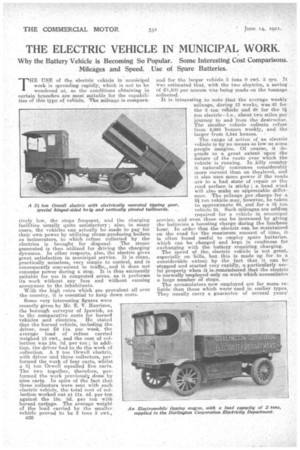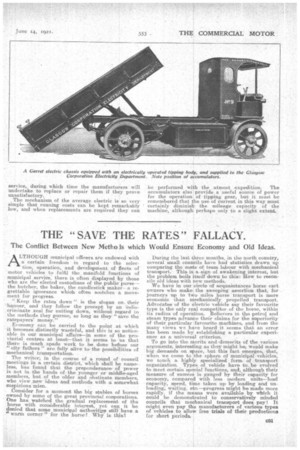THE ELECTRIC VEHICLE IN MUNICIPAL WORK.
Page 30

Page 31

If you've noticed an error in this article please click here to report it so we can fix it.
Why the Battery Vehicle is Becoming So Popular. Some Interesting Cost Comparisons. Mileages and Speed. Use of Spare Batteries.
THE USE of the electric vehicle in municipal work is spreading rapidly, which is not to be wondered 'at, as the conditions obtaining in certain branches are most suitable for the capabilities of this type of vehicle. The mileage is compara
tively low, the stops frequent, and the charging facilities usually quite satisfactory ; also, in many cases, the vehicles can actually be made to pay for their own power by utilizing steam-producing boilers as incinerators, to which refuse collected by the electrics is brought. for disposal. The steam generated is then utilized for driving the charging dynamos. In other respects, also, the electric gives great satisfaction in municipal service. It is clean, practically noiseless, very simple to control, and is i consequently convenient n traffic,„ and it does not consume power during a stop. It is thus eminently suitable for use in congested areas, as it performs its work without any fuss and without causing annoyance to the inhabitants. With the high rates which are prevalent all over the country, it is essential to keep down costs. Some very interesting figures were
recently given by Mr. E. V. Harrison, the borough surveyor of Ipswich, as to the comparative costs for horsed vehicles and eleetrics. He stated that the horsed vehicle, including the driver, cost 26 lls, per week, the average load of refuse carried weighed 13 .cwt., and the cost of collection was 18s. 3c1. per ton; in addition, the driver had to rib the work of collection. A 2 ton Orwell electric, with driver and three collectors, performed the, work of four carts, whilst a n ton Orwell equalled five carts. The two together, therefore, performed the work previously done by nine carts. In spite of the fact that three collectors were sent with -each electric vehicle, the total cost of collection worked out at us. 4d. per ton against the 18s. 3d. per ton with horsed cartage. The average weight of the load carried by the smaller vehicle proved to be 2 tons 3 cwt.,
C30 and for the larger vehicle 3 tons 0 cwt. 3 qrs. It was estimated that, with the two electrics, a saving of 21,500 per annum was being made on the tonnage collected.
It is interesting to note that the average weekly mileage, during 13 weeks, was 61 for the 2 ton vehicle and 68 for the 3i ton electric—i.e.' about two miles per jdurney to and from the. destructor. The smaller vehicle collects refuse from 2,995 houses weekly, and the larger from 3,544 houses.
The range of action of an electric vehicle, is. by no means so low as some people imagine. Of course, it depends to a great extent upon the -nature of the route over which the vehicle is running. In hilly country it. naturally consumes considerably more current than on thealevel, and it also uses more power if the roads are in a bad state of repair or the road surface is sticky ; a head wind will also make an appreciable difference. The mileage per charge for a 2i ton vehicle may, however, be taken to approximate 40, and for a .3f ton vehicle 35. Such mileages are seldom. requiredfor a vehicle in municipal service, and even these can be increased by giving the batteries a boosting charge cluring the luncheon hour. In order that the electric can, be maintained on the road for 'the maximum amount of time, it is often fowiel useful to employ spare batteries, which can be eharged and kept in readiness for exchanging with the battery requiring charging. The speed of the, electric vehicle is not great, especially on hills, but this is made up for to a considerable extent by the fact that it can be stopped and started very rapidly, a particularly useful property when it isJern.embered that the ele.etric is normally employed only on work which necessitates a large number of stops.
The accumulators now employed are far more reliable than those which were used in earlier types. They usually carry a guarantee of several years' service, during which time the manufacturers will undertake to replace or repair them if they prove unsatisfactory. The mechanism of the average electric is so very simple that running costs can be kept remarkably low, and when replacements are required they can be performed with the utmost expedition. The accumulators also provide a useful source of power for the operation of tipping gear, but it must be remembered that the use of current in this way must certainly diminish the mileage capacity of the machine, although perhaps only to a slight extent..






































